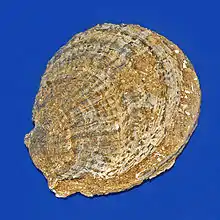Hinnites
Hinnites is a genus of rock scallops, marine bivalve mollusks in the family Pectinidae, the scallops.[1]
| Hinnites | |
|---|---|
 | |
| Fossil valve of Hinnites crispus from Pliocene of Italy | |
| Scientific classification | |
| Kingdom: | Animalia |
| Phylum: | Mollusca |
| Class: | Bivalvia |
| Order: | Pectinida |
| Family: | Pectinidae |
| Genus: | Hinnites DeFrance, 1821 |
These mollusks have been recorded as fossils from the Triassic to the Quaternary (from 235.0 to 0.126 Ma). Fossils have been found in the sediments of Algeria, Angola, Tanzania, Ethiopia, South Africa, Oman, Saudi Arabia, United States, Australia and of various European countries.[2]
Description
This genus include scallops with thick shells resembling that of an oyster.[3]
Himnites is unusual in that, like the extant taxon Crassadoma gigantea, it was free-swimming as a juvenile, but subsequently cemented itself to a hard substrate.
Species
Species within the genus Hinnites include:[2]
- Hinnites cortesyi Defrance 1821
- Hinnites crispus † (Brocchi, 1814)
- Hinnites denticostatus † Klipstein 1843
- Hinnites distortus (da Costa, 1778) [4]
- Hinnites ercolanianus † Cocconi 1873
- Hinnites giganteus (Gray, 1825) (synonym of Crassadoma gigantea)[5]
- Hinnites granulosus † Klipstein 1843
- Hinnites multirugosus (Gale, 1928) [6]
- Hinnites obliquus † Münster 1841
References
- ITIS
- Paleobiology Database
- Merrian-webster
- Femorale
- "Wallawalla". Archived from the original on 2015-06-26. Retrieved 2015-06-26.
- D.L.Leighton A growth profile for the rock scallop Hinnites multirugosus held at several depths off La Jolla, California
This article is issued from Wikipedia. The text is licensed under Creative Commons - Attribution - Sharealike. Additional terms may apply for the media files.